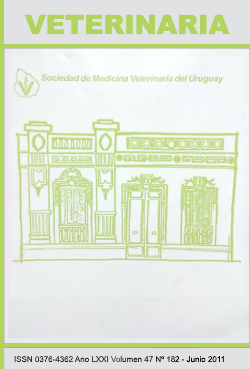Comparison of three methods of synchronization of heat and ovulation with and without fixed time artificial insemination (FTAI) in beef heifers
Keywords:
Fixed time insemination, Prostaglandins, Ovsynch, HeatsynchAbstract
To evaluate the efficiency of protocols for synchronization of estrus and ovulations in cycling beef heifers, an experiment was conducted including three treatments in three farms during two consecutive years. The treatments were: Modified-Ovsynch (OSYM) (n=1426), Modified-Heatsynch (HSYM) (n=1229) and Double Prostaglandin (DPG) given at a 14-day interval (n=1451). In the fixed-time artificial insemination (FTAI) protocols -OSYM and HSYM-, heat detection was done twice a day from Day 5 PM to Day 7 PM, and the animals in heat were inseminated using the AM/PM rule; the FTAI was done on the OSYM and HSYM protocols to the animals that did not show heat during the three days mentioned before. In the DPG treatment, heat detection and artificial insemination started 36 hours after the second prostaglandin (PG), and was done for five consecutive days. The Pregnancy Rate (PR) showed significant differences between years (67.6% and 56.6% to the years 1 y 2 respectively; P<0.0001) and farms (farm A= 71.4; B= 62.3% and C= 56.8%; P<0.0001). There were no statistical differences between the farms B and C (62.3% and 56.8%; P<0.05) but both were different to farm A (71.4%, P <0.0001). All three protocols were efficient, but those with IATF resulted in better pregnancy rates.











